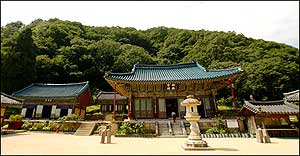
|
|
|
Home Asia Pacific North Asia S/N Korea News & Issues Explore 'Divinely Inspired' Sinhung TempleBy Roger Shepherd, The Korea Times, Sept 10, 2009Seoul, South Korea -- Sinhung Temple has been running their new templestay program in outer Mt. Seorak National Park for the past four months.
So far 700 persons have used the program mostly on the weekends; only a few foreigners are aware of the new program. I had been asked to go there and take a look at the new program and take in the surroundings. The temple has a history dating back to the 7th century. Sinhung Temple is also affectionately known as the temple of "frequent change" and it is the main temple of the area known as outer Mt. Seorak, or the eastern side of the National Park area of Mt. Seorak, Gangwon Province.
The last three remaining monks had a vision in which they were ordained to rebuild the temple behind the original site, where it stands now, giving the temple protection against the three main disasters of fire, water and wind. After that, the temple got its current name Sinhung Temple, meaning "Divinely Inspired Temple." Subsequent reconstructions have occurred in various parts of the present site over time. I arrived mid afternoon on a beautifully hot, blue, and clear late summer's day, at the foot of the high craggy mountains of the Baekdu-daegan Mountain System that dominate this remarkable region of Korea. Upon arrival I met Canadian Veronique Gagne who was making her first temple stay visit. The one-night, two-day program was to be tutored by Ven. Ji Sung, a 40-year-old monk whom has been in the Jogye Order for 15 years. After being kitted out in an olive green garb containing comfortable baggy hemp-styled trousers and a rather snazzy looking waistcoat, we were taken into the study hall of the main grounds. There we were handed an English itinerary of the program. In total, there were about 25 students attending this weekend, consisting mainly of middle-aged Koreans. After being shown a video on temple etiquette, a tea ceremony and conversation with Ven. Ji Sung took place. This part of the program could be likened to a "getting to know each other" period, where green tea is served and casual conversation takes place.
An hour later it was time for what looked like the first serious part of the schedule. "Balwoo-gongyang" is the practice of eating Buddhist meals with traditional bowls. The word "balwoo" derives from ancient Sanskrit and means "bowls with appropriate content." "Gongyang" means the name for meals in a temple which are offered as donation. Sitting on the floor in two ranks facing each other, we were handed a stack of bowls that were neatly wrapped in cloth. Guided by the monk, we were shown the correct procedure of un-wrapping the bowls and placing them out onto a cloth in an orderly manner. We were then served a small but equal amount of food each consisting of rice, vegetables, and one piece of pickled "mu" or radish. Eating is conducted silently so as to cultivate a sense of gratitude, equality, and harmony in the mind. At the end of the session you clean each bowl individually with water, using the piece of "mu" as your cleaning sponge. I unfortunately ate mine during the eating process, and was frowned on by a monk - he quickly saw the funny side to it and replaced my eaten one with his. At the end of eating and cleaning there should not be one grain of food left in any bowl. The bowls are then re-bundled and re-wrapped with the same strictness as which they were un-wrapped. Two hours later we were introduced to the practice of "chamseon," or meditation. This time we were lined in three rows facing a monk, who talked about the intricacies of this Buddhist practise. It was understandably all in Korean, and at the end of his presentation we all sat in either the full or half lotus position and tried to meditate. I tried my best to switch off, but found this technique quite hard, so in turn I just closed my eyes and took in the peacefulness of what was now the night. Soon afterwards, the two foreigners were taken into another room where, with a translator, we were able to talk about the subject of meditation. The monk explained how important it was to release tension from your body as this prevents stability of the mind. Once you have achieved that, then the next stage is to try and take all the thoughts that enter your mind and store them into your lower stomach area and then observe your feelings, this can also be seen as a breathing technique. We then talked about "hwadu," which is focused meditation. This involves you asking yourself a deep and meaningful question and then focusing on that whilst meditating. The objective is to reach a state called "ganhwaseon" where you become tranquil with your hwadu, allowing you to cut off outside distractions, removing all noise in your mind and becoming one with your point of focus. I never attained ganhwaseon, nor did I manage to even find hwadu, but I did learn something about chamseon. The next morning everyone awoke at 4 a.m. to attend "yebul," or the Buddhist Ceremonial Service in the main prayer hall. Most of us including the Korean contingent didn't know much about the procedure of worship, so instead tried to follow the actions of the monks. I, having just spent a month at a hermitage, was at least able to keep in time with the calls of the "moktak," a wooden percussion instrument, while others fell out of place, making the scene look rather awkward at times - I'm sure Buddha himself would understand. At 5 a.m. we returned to the study hall to perform a session of "jeol" - a favorite routine of mine - also known as the 108 bows. It involves the technique of the five-point bow "o-che-tu-ji," where the forehead, elbows, and knees touch the ground. Starting in a standing position with hands clasped together in prayer, you drop down to your knees, lean forward placing your two hands on the floor shoulder width apart, and then bring your forehead and elbows to the floor. You then turn the palms of your hands skyward, then turn them over, and then return to the standing position. This is repeated 108 times. I had learned and practiced this form of exercise, yoga, or meditation everyday for the last month at my hermitage and find it a useful form of physical exercise. The meaning of the number 108 originates from the six roots of eyes, ears, nose, tongue, body and mind, similar to the five senses, but Buddhism treats the mind as an extra sense or organ. From these six roots derive the six senses of color, smell, sound, taste, touch, and phenomena. The combination of the six roots meeting the six senses causes emotions both good and bad, this totals 36 afflictions, as these afflictions occur in the past, present, and future, then we multiply 36 by three to get 108. This act is supposed to bring humility to the user, causing you to look inward instead of outward. I actually find this procedure easier and more rewarding than the harder to achieve cham-seon, or meditation. The rest of the morning was spent taking in breakfast, followed by a walk and then some free acupuncture with the monk, performed by a specialist. After that we attended the last session of the program, where we were all given the opportunity to learn the heart sutra chanting of the name of the Buddha. Although I am familiar with the sound of the chant, I unfortunately did not know enough about the actual pronunciation of the hangeul version of what is a Chinese Buddhist chant. At the end, the monk walked around the class and prodded us each in the forearm with three sticks of burning incense, leaving a scar that still remains today. This is called "sugaeshik" which serves to remind laymen Buddhists of the five precepts that we need to abstain from, they are killing, stealing, sexual misconduct, lying and intoxication. They are normally given a Buddhist name after the ceremony. I kept my name because I think I've got quite a bit more to learn before I can wear my scars proudly. Despite the language difficulties, I did learn a lot more about Korean Buddhism, enough to make me go back and take in more. To get to Sinhung Temple from Seoul, take an express bus to the final station in Sokcho and get off to switch to bus No. 9. For more information, call (033)-636-7044. |
 |
|
| Korean Buddhist News from BTN (Korean Language) |
|
 |
|
|
Please help keep the Buddhist Channel going |
|
| Point
your feed reader to this location |
|

 << The main yard of Sinhung Temple, located at Mt. Seorak, Gangwon Province, is seen in this photo. This temple, among others scattered around the country, offers a templestay program. / Courtesy of Roger Shepherd
<< The main yard of Sinhung Temple, located at Mt. Seorak, Gangwon Province, is seen in this photo. This temple, among others scattered around the country, offers a templestay program. / Courtesy of Roger Shepherd

